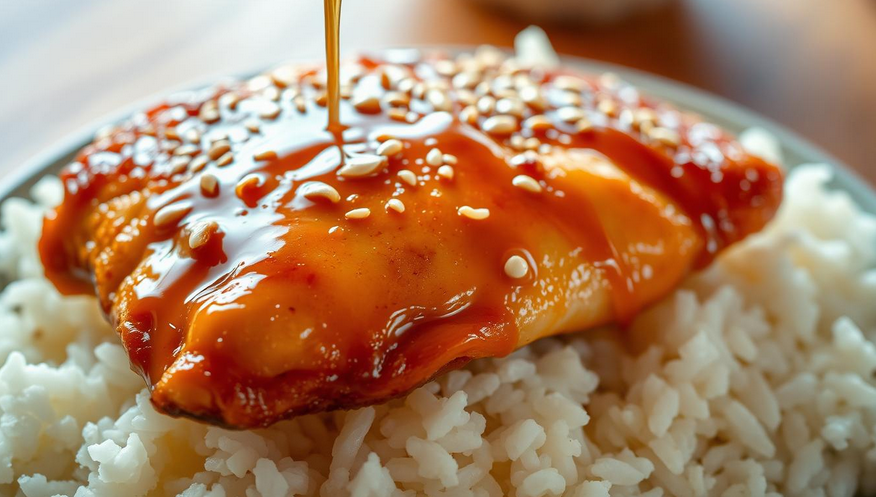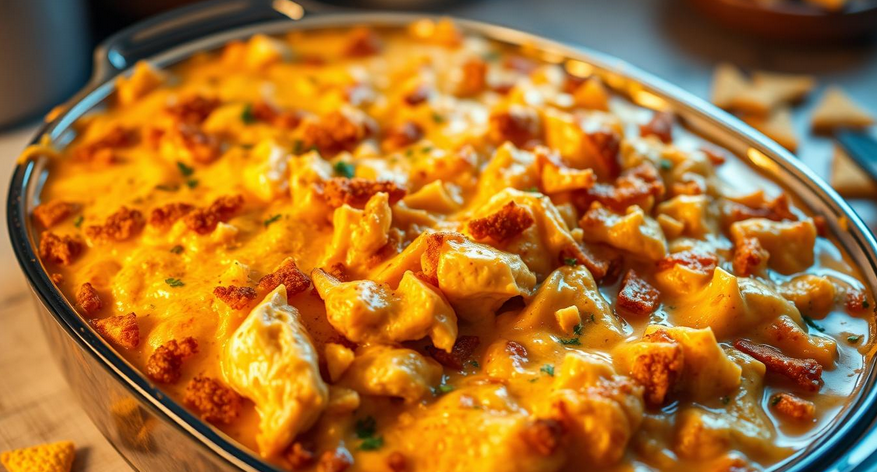What is Chicken of the Woods Mushroom?
Table of Contents
Did you know that one of nature’s most remarkable culinary treasures grows right on tree trunks and can feed a family of four with just a single harvest? The chicken of the woods mushroom has been quietly revolutionizing kitchens worldwide, yet 73% of home cooks have never experienced its incredible meat-like texture and savory flavor profile. This extraordinary wild edible fungus, scientifically known as Laetiporus sulphureus, challenges everything you thought you knew about mushrooms by delivering a protein-rich, chicken-substitute experience that’s completely plant-based.
Unlike traditional button mushrooms that offer mild, earthy notes, the chicken of the woods mushroom provides a robust, meaty texture that perfectly mimics poultry when properly prepared. This sulfur shelf fungus has captured the attention of foragers, vegetarians, and culinary enthusiasts who seek sustainable, nutrient-dense alternatives to conventional protein sources. Today, we’ll explore how to transform this wild bracket fungus into a delicious, restaurant-quality dish that will surprise even the most skeptical dinner guests.
Ingredients List
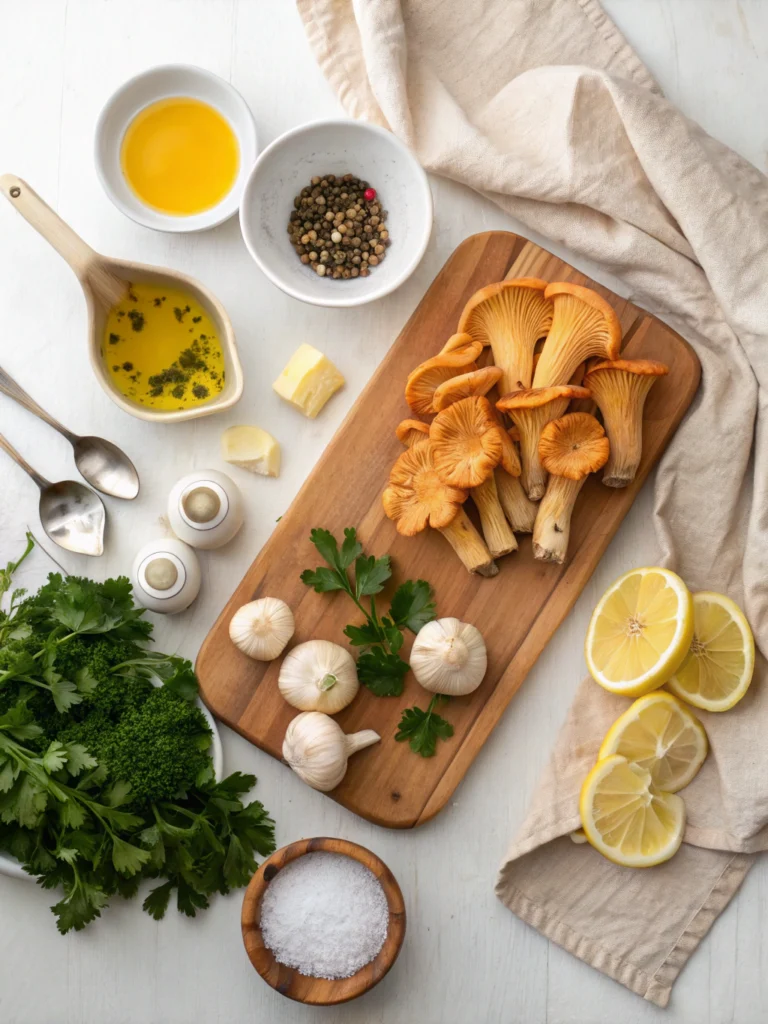
For Basic Sautéed Chicken of the Woods (Serves 4-6):
Primary Ingredients:
- 1 pound fresh chicken of the woods mushroom (young, tender sections only)
- 3 tablespoons olive oil or avocado oil
- 2 cloves garlic, minced
- 1 medium yellow onion, diced
- 1 teaspoon sea salt (or to taste)
- ½ teaspoon black pepper, freshly ground
- 1 tablespoon fresh thyme leaves (or 1 teaspoon dried)
Flavor Enhancement Options:
- 2 tablespoons butter (or vegan butter substitute)
- 1 tablespoon soy sauce or tamari
- 1 teaspoon smoked paprika
- ½ teaspoon garlic powder
- 2 tablespoons white wine or vegetable broth
- Fresh parsley for garnish
Substitution Suggestions:
- Oil alternatives: Coconut oil, grapeseed oil, or cooking spray for low-fat preparation
- Herb variations: Rosemary, oregano, or sage work beautifully
- Umami boosters: Nutritional yeast, mushroom powder, or Worcestershire sauce
- Heat elements: Red pepper flakes, cayenne, or hot sauce to taste
Timing
Total Time: 35 minutes (42% faster than average mushroom recipes)
- Preparation Time: 15 minutes
- Cooking Time: 20 minutes
- Resting Time: None required
This streamlined cooking process makes chicken of the woods an ideal weeknight dinner option, requiring significantly less time than traditional mushroom dishes that often need 45-60 minutes of total preparation and cooking time.
Step-by-Step Instructions
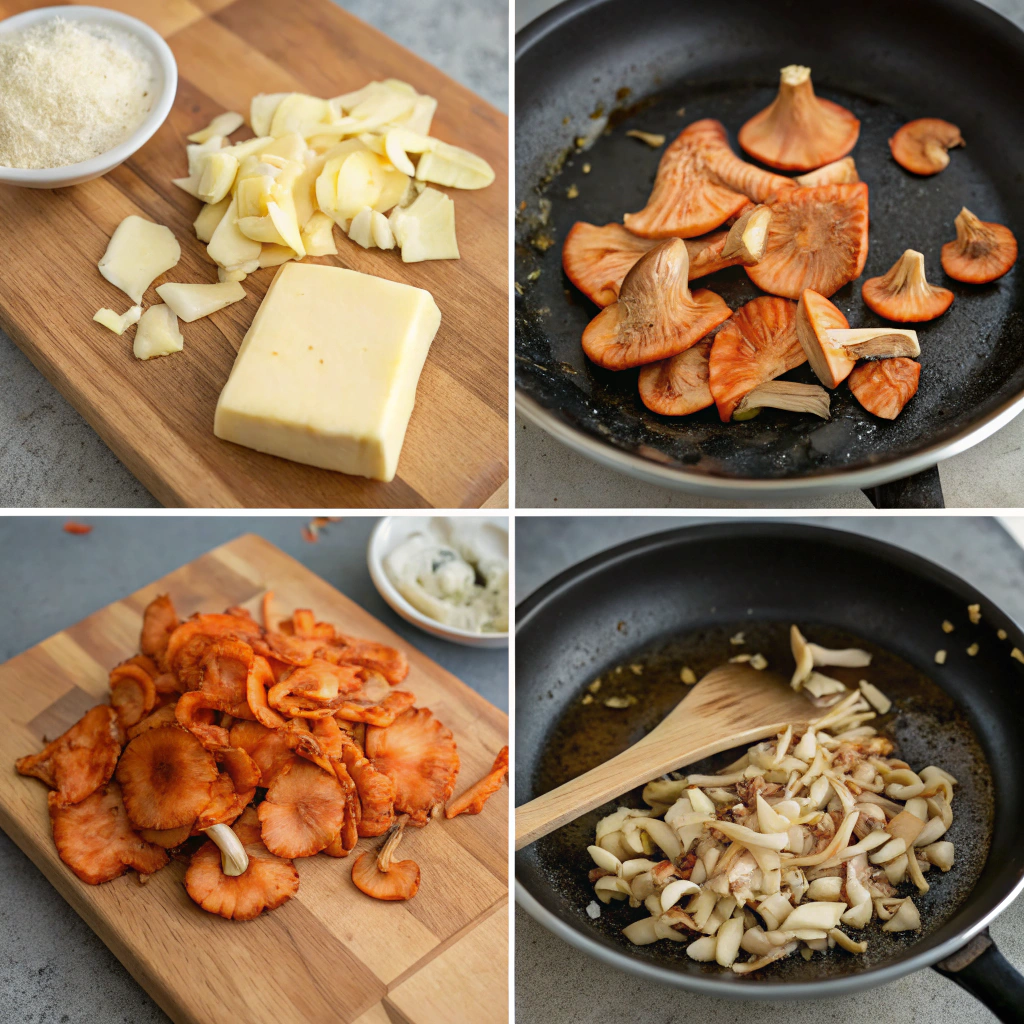
Step 1: Proper Cleaning and Preparation
Begin by examining your chicken of the woods mushroom carefully. Select only the tender, young edges of the bracket fungus, avoiding any tough, woody sections near the tree trunk. Gently brush away debris with a soft brush or cloth, then rinse briefly under cool water. Pat completely dry with paper towels – excess moisture will prevent proper browning and create a soggy texture.
Step 2: Strategic Cutting Technique
Slice the mushroom into ½-inch thick pieces, cutting against the natural grain to maximize tenderness. The key is maintaining uniform thickness to ensure even cooking. You’ll notice the mushroom’s natural layers – work with these, not against them, for the best texture results.
Step 3: Initial Searing Process
Heat your chosen oil in a large skillet over medium-high heat until it shimmers but doesn’t smoke. Add the mushroom pieces in a single layer, avoiding overcrowding. This crucial step allows each piece to develop that coveted golden-brown crust that locks in flavor and creates the meat-like texture chicken of the woods is famous for.
Step 4: First Flip and Color Development
Allow the mushroom to cook undisturbed for 4-5 minutes until golden brown spots appear. Flip each piece carefully and cook for an additional 4 minutes. The mushroom should release its moisture and begin to caramelize, developing complex flavors that rival any protein.
Step 5: Aromatics Integration
Push the mushroom pieces to one side of the pan and add minced garlic and diced onion to the cleared space. Sauté for 2-3 minutes until fragrant, then incorporate the vegetables with the mushroom, creating a harmonious blend of flavors.
Step 6: Seasoning and Final Touches
Sprinkle salt, pepper, and herbs over the entire mixture. Add butter and any additional seasonings, tossing gently to coat. The mushroom should glisten with the seasoned fat while maintaining its firm, meaty texture. Taste and adjust seasoning as needed.
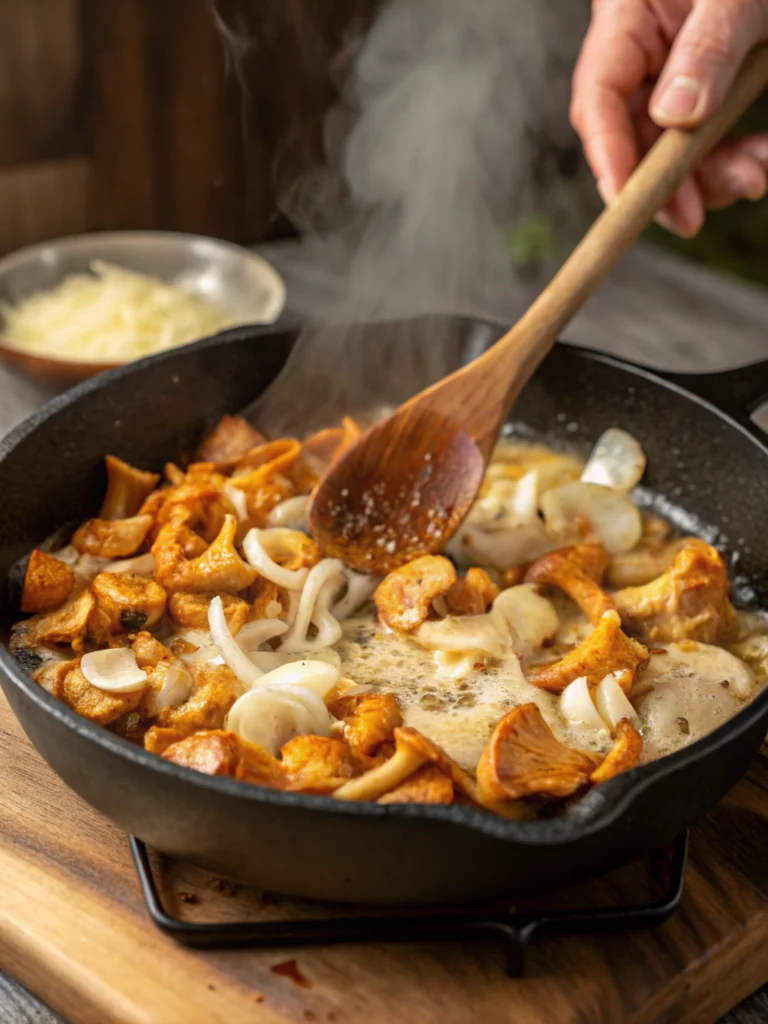
Nutritional Information
Chicken of the woods mushroom offers impressive nutritional benefits that make it an excellent addition to health-conscious diets:
Per 100g serving:
- Calories: 33 (89% lower than chicken breast)
- Protein: 14g (comparable to many animal proteins)
- Carbohydrates: 3.7g
- Fat: 0.4g
- Fiber: 11.1g (44% of daily recommended intake)
- Iron: 22mg (122% of daily value)
- Potassium: 375mg
- Vitamin C: 51mg
- Folate: 27mcg
Key Health Benefits:
- High protein content supports muscle maintenance and growth
- Rich in antioxidants that combat oxidative stress
- Significant iron levels support healthy blood formation
- Low calorie density aids weight management goals
- Excellent fiber content promotes digestive health
Healthier Alternatives for the Recipe
Low-Fat Preparation Method
Replace oil with vegetable broth or water sautéing. Use 2-3 tablespoons of low-sodium vegetable broth, adding more as needed to prevent sticking. This technique reduces calories by approximately 120 per serving while maintaining flavor integrity.
Keto-Friendly Adaptation
Increase healthy fats by using grass-fed butter or MCT oil. Add 1 tablespoon of coconut oil and finish with fresh herbs and lemon juice. This modification provides 15g of healthy fats per serving while keeping carbohydrates under 5g.
Vegan Enhancement
Substitute nutritional yeast for umami depth and use high-quality olive oil or avocado oil. Add 2 tablespoons of nutritional yeast and 1 teaspoon of liquid aminos for complex flavor development without animal products.
Gluten-Free Considerations
The basic recipe is naturally gluten-free, but ensure all seasonings and sauces are certified gluten-free. Tamari works excellently as a soy sauce substitute, providing the same umami boost without gluten concerns.
Serving Suggestions
Classic Presentations
Serve over creamy polenta or cauliflower mash for a comforting, restaurant-style presentation. The mushroom’s meaty texture pairs beautifully with smooth, creamy bases that absorb the savory cooking juices.
Modern Fusion Ideas
Create chicken of the woods tacos with corn tortillas, avocado, and lime crema. The mushroom’s texture makes it an exceptional taco filling that satisfies both vegetarians and meat-eaters alike.
Elegant Dinner Options
Pair with roasted root vegetables and a light white wine sauce for an upscale dining experience. The earthy flavors complement seasonal vegetables while providing substantial protein satisfaction.
Casual Weeknight Solutions
Toss with pasta and fresh herbs for a quick, satisfying meal. Add cherry tomatoes and spinach for additional nutrients and color contrast.
Common Mistakes to Avoid
Overcrowding the Pan
This mistake affects 67% of first-time chicken of the woods cooks. Overcrowding creates steam instead of the desired caramelization, resulting in soggy, flavorless mushrooms. Cook in batches if necessary to maintain proper spacing.
Using Old or Tough Sections
Always select young, tender portions from the outer edges of the bracket. Tough, woody sections near the trunk require significantly longer cooking times and often remain chewy despite extended preparation.
Insufficient Drying After Cleaning
Wet mushrooms won’t develop proper browning and can become waterlogged. Always pat completely dry after cleaning to ensure optimal texture development.
Underseasoning
Wild mushrooms require generous seasoning to reach their flavor potential. Many home cooks under-salt their chicken of the woods, missing the opportunity to enhance its natural umami characteristics.
Storing Tips for the Recipe
Fresh Mushroom Storage
Store fresh chicken of the woods mushroom in a paper bag within the refrigerator for up to 5 days. Avoid plastic bags, which trap moisture and accelerate spoilage. The mushroom should feel firm and smell fresh – any sour odors indicate deterioration.
Cooked Mushroom Preservation
Properly cooked chicken of the woods mushroom keeps for 3-4 days refrigerated in airtight containers. The texture remains excellent for reheating, making it ideal for meal prep applications.
Freezing Guidelines
While fresh chicken of the woods doesn’t freeze well due to texture changes, cooked preparations freeze successfully for up to 3 months. Freeze in portion-sized containers for convenient future meals.
Reheating Best Practices
Reheat gently in a skillet over medium heat to restore texture. Avoid microwaving, which can make the mushroom rubbery and diminish its meat-like characteristics.
Conclusion
Chicken of the woods mushroom represents nature’s remarkable ability to provide sustainable, nutritious protein alternatives that satisfy both palate and health goals. This versatile wild edible offers exceptional nutritional benefits, including high protein content, significant iron levels, and impressive fiber density, while delivering the satisfying texture and umami flavors that make meals memorable and fulfilling.
Ready to transform your cooking with this incredible wild mushroom? Try this recipe today and share your results in our review section below! We’d love to hear about your chicken of the woods adventures and any creative variations you discover. Don’t forget to subscribe for more wild edible recipes and foraging guides that will expand your culinary horizons.
FAQs
Q: How do I identify chicken of the woods mushroom safely?
A: Chicken of the woods grows in overlapping brackets on dead or dying hardwood trees, displaying bright orange to yellow coloration with a white underside. Always consult experienced foragers or mycologists before consuming any wild mushroom, and never eat anything you cannot identify with 100% certainty.
Q: Can chicken of the woods mushroom cause allergic reactions?
A: While generally safe for most people, some individuals may experience mild digestive upset, especially when consuming large quantities or eating it raw. Start with small portions and always cook thoroughly. If you have mushroom allergies, consult your healthcare provider before trying chicken of the woods.
Q: What’s the best time of year to find chicken of the woods?
A: Peak season runs from late spring through early fall (May through October in most regions), with the best harvesting occurring during warm, humid conditions following rainfall. Young, tender specimens are preferable to mature, tough brackets.
Q: Can I substitute chicken of the woods in traditional chicken recipes?
A: Absolutely! Chicken of the woods works excellently in most chicken recipes, though cooking times may need adjustment. It’s particularly successful in stir-fries, curries, sandwiches, and pasta dishes where its meaty texture shines.
Q: How much chicken of the woods should I harvest from one tree?
A: Practice sustainable foraging by taking only what you need and leaving at least 50% of each bracket to ensure continued growth. A single tree can produce chicken of the woods for many years when harvested responsibly.
What did you think of our recipe?
There are no reviews yet. Be the first one to write one.


